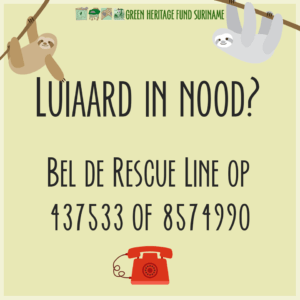Animal Rescue Missions
Sloths and anteaters are victimized by urban sprawl in Paramaribo. As the city grows, their forest habitat is lost. Thus, three- and two-fingered sloths, anteaters (silky, lesser or giant) end up in people’s gardens and houses and come in conflict with dogs. People often are scared, or are afraid their small children can be hurt by these now homeless animals. In addition, the changing climate is clearly making an additional impact on the animals surviving in the small forest fragments.
After sloths, anteaters and armadillos are saved from difficult situations, they are cared for in our professional shelter prior to release. The aim is to minimize trauma caused to the wild animals by contact with humans. Thus reducing rehabilitation time and improving survival chances for the sloths, anteaters and armadillos in trouble.
Every now and then we also rescue Brazilian porcupines.
Pale-throated Three-toed Sloth /Drievingerige Luiaard/ Sonloiri / Drifinga-loiri
Lesser Anteater/ Zuidelijke Boommiereneter/ Mirafroiti
Soutern Tamandua/ Lesser Anteater/ Zuidelijke Boommiereneter/ Zuidelijke Tamanua/ Mirafroiti
Linnaeus' Two-toed Sloth /Tweevingerige Luiaard / Skapuloiri
Linnaeus' or Southern Two-toed Sloth /Tweevingerige Luiaard / Skapuloiri / Tufinga-loiri
Pigmy or Silky Anteater/ Dwergmiereneter/ Likanu
Pigmy or Silky Anteater Dwergmiereneter/ Wespeneter/ Likanu
Giant Anteater/ Reuzenmiereneter/ Tamanuwa
Giant Anteater Reuzenmiereneter Tamanuwa
Brazilian porcupine/ Grijpstaartstekelvarken/ Gindyamaka
Brazilian porcupine/ Grijpstaartstekelvarken/ Gindyamaka
Rescue Line
In case you have an anteater, sloth or armadillo in need you can reach us at
437533 or 8574990

